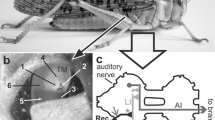Summary
-
1.
Ampullary electroreceptors of the transparent catfishKryptopterus bicirrhus were studied in situ and in an isolated fin preparation. A microelectrode in the ampulla or beneath the receptor epithelium recorded discharges of the afferent fiber. The receptors are sensitive tonic receptors and the tonic discharge was markedly modified by stimuli as low as 0.1 mV applied at the ampullary opening, anodal (outside positive) stimuli being excitatory and cathodal stimuli being inhibitory (Fig. 1).
-
2.
Strong anodal stimuli excited the fiber with a minimum delay of about 1.3 ms (Fig. 2). Further increase in stimulus strength led to a jump in latency to less than 0.3 ms, ascribable to direct stimulation of the afferent fiber. Thus, there is a minimum synaptic delay of about 1 ms. A brief strong excitatory stimulus was followed by an after-discharge that could not be blocked by strong inhibitory stimuli (Fig. 3). These data are difficult to explain by electrical transmission from receptor celt to afferent fiber, but are consistent with chemical transmission.
-
3.
Provided the skin barrier to penetration of solutes was disrupted, high Mg+2 solutions (15–30 mM) produced a rapid and reversible depression of spontaneous and evoked discharges (Figs. 4–5). High Ca+2 solutions (15 mM) had little effect.
-
4.
L-glutamate at a concentration of 1 μM strongly excited the afferent fiber. The excitation also occurred when spontaneous and stimulus evoked activity was blocked by high Mg+2 solution. L-glutamate at 1 mM transiently excited, then blocked the afferent fiber, probably by excessive depolarization of the terminals (Figs. 6, 7).
-
5.
GABA, L-aspartate, D-glutamate (Fig. 8) and cholinergic drugs had little effect.
-
6.
We conclude that transmission from receptor cell to afferent fiber is chemically mediated by a Ca dependent process, and that L-glutamate is a candidate transmitter for this synapse.
Similar content being viewed by others
References
Bennett MVL (1965) Electroreceptors in mormyrids. Cold Spring Harbor Symp Quant Biol 30:235–262
Bennett MVL (1967) Mechanisms of electroreception. In: Cahn P (ed) Lateral line detectors. Indiana University Press, Bloomington, pp 313–393
Bennett MVL (1971a) Electroreception. In: Hoar WS, Randall DJ (eds) Fish physiology, vol 5, Sensory systems and electric organs. Academic Press, New York, pp 493–574
Bennett MVL (1971b) Electrolocation in fish. Ann NY Acad Sci 188:242–269
Bennett MVL (1977) Electrical transmission: a functional analysis and comparison to chemical transmission. In: Kandel ER (ed) Cellular biology of neurons, vol I, sect I, Handbook of physiology, The nervous system. Williams and Wilkins, Baltimore, pp 357–416
Bretschneider F, Kroesbergen G, Beijnick FB (1979) Functioning of catfish electroreceptors: relation between skin potential and receptor activity. J Physiol (Paris) 75:343–437
Flock A, Lamb DMK (1974) Neurotransmitter synthesis in inner ear and lateral line sense organs. Nature 249:142–144
Mullinger AM (1964) The fine structure of ampullary electroreceptors inAmiurus. Proc R Soc Lond [Biol] 160:345–359
Obara S (1974) Receptor cell activity at “rest” with respect to the tonic operation of a specialized lateralis receptor. Proc Jpn Acad 50:386–391
Obara S (1976) Mechanisms of electroreception in ampullae of Lorenzini of the marine catfishPlotosus. In: Reuben JP, Purpura DP, Bennett MVL, Kandel ER (eds) Electrophysiology of nerve, synapse and muscle. Raven Press, New York, pp 129–147
Obara S, Bennett MVL (1972) Mode of operation of ampullae of Lorenzini of the skate,Raja. J Gen Physiol 60:534–557
Obara S, Oomura Y (1973) Disfacilitation as the basis for the sensory suppression in a specialized lateralis receptor of the marine catfish. Proc Jpn Acad 49:213–217
Roth A (1968) Electroreception in the catfish,Amiurus nebulosus. Z Vergl Physiol 61:196–202
Roth A (1971) Zur Funktionsweise der Elektrorezeptoren in der Haut von Welsen (Ictalurus): Der Einfluss der Ionen in Süßwasser. Z Vergl Physiol 75:303–322
Roth A (1972) Wozu dienen die Elektrorezeptoren der Welse? J Comp Physiol 79:113–135
Roth A (1978) Further indications of a chemical synapse in the electroreceptors of the catfish. J Comp Physiol 126:147–150
Roth A, Tscharntke H (1976) Ultrastructure of the ampullary electroreceptors in lungfish and Brachiopterygii. Cell Tissue Res 173:95–108
Steinbach AB (1974) Transmission from receptor cells to afferent nerve fibers. In: Bennett MVL (ed) Synaptic transmission and neuronal interaction. Raven Press, New York, pp 105–140
Steinbach AB, Bennett MVL (1971) Effects of divalent ions and drugs on synaptic transmission in phasic electroreceptors in a mormyrid fish. J Gen Physiol 58:580–598
Szamier RB, Wachtel AW (1969) Special cutaneous receptor organs of fish. III. The ampullary organs ofEigenmannia. J Morphol 128:261–290
Szamier RB, Wachtel AW (1970) Special cutaneous receptor organs of fish. VI. Ampullary and tuberous organs ofHypopomus. J Ultrastruct Res 30:450–471
Teeter JH, Bennett MVL (1975) Synaptic transmission in an acousticolateralis receptor. Neurosci Abstr 1:648
Teeter JH, Szamier RB, Bennett MVL (1980) Ampullary electroreceptors in the sturgeon.Scaphirhynchus platorynchus (Rafinesque). J Comp Physiol 138:213–223
Wachtel AW, Szamier RB (1969) Special cutaneous receptor organs of fish. IV. Ampullary organs of the nonelectric catfish,Kryptopterus. J Morphol 128:291–308
Zipser B, Bennett MVL (1973) Tetrodotoxin resistant electrically excitable responses of receptor cells. Brain Res 62:253–259
Author information
Authors and Affiliations
Additional information
This work was supported in part by grants NS-12627, NS-07512 and HD-04248. J.H.T. held a National Research Service Award.
Rights and permissions
About this article
Cite this article
Teeter, J.H., Bennett, M.V.L. Synaptic transmission in the ampullary electroreceptor of the transparent catfish,Kryptopterus . J. Comp. Physiol. 142, 371–377 (1981). https://doi.org/10.1007/BF00605449
Accepted:
Issue Date:
DOI: https://doi.org/10.1007/BF00605449



